The U.S. government on Tuesday acknowledged, for the first time, the harmful role it has played over the past century in building and operating dams in the Pacific Northwest — dams that devastated Native American tribes by inundating their villages and decimating salmon runs while bringing electricity, irrigation and jobs to nearby communities.
In a new report, the Biden administration said those cultural, spiritual and economic detriments continue to pain the tribes, which consider salmon part of their cultural and spiritual identity, as well as a crucial food source.
The government downplayed or accepted the well-known risk to the fish in its drive for industrial development, converting the wealth of the tribes into the wealth of non-Native people, according to the report.
"The government afforded little, if any, consideration to the devastation the dams would bring to Tribal communities, including to their cultures, sacred sites, economies, and homes,” the report said.
It added: “Despite decades of efforts and an enormous amount of funding attempting to mitigate these impacts, salmon stocks remain threatened or endangered and continued operation of the dams perpetuates the myriad adverse effects.”
The Interior Department's report comes amid a $1 billion effort announced earlier this year to restore the region’s salmon runs before more become extinct — and to better partner with the tribes on the actions necessary to make that happen.
That includes increasing the production and storage of renewable energy to replace hydropower generation that would be lost if four dams on the lower Snake River are ever breached. Tribes, conservationists and even federal scientists say that would be the best hope for recovering the salmon, providing the fish with access to hundreds of miles of pristine habitat and spawning grounds in Idaho.
“President Biden recognizes that to confront injustice, we must be honest about history – even when doing so is difficult,” said a statement from White House Council on Environmental Quality Chair Brenda Mallory and Interior Secretary Deb Haaland, the first Native American cabinet secretary. “In the Pacific Northwest, an open and candid conversation about the history and legacy of the federal government’s management of the Columbia River is long overdue.”
Northwest Republicans in Congress and some business and utility groups oppose breaching the dams, saying it would jeopardize an important shipping route for farmers and throw off clean-energy goals. GOP Rep. Cathy McMorris Rodgers, who represents eastern Washington, called Tuesday's report a “sham."
“This bad faith report is just the latest in a long list of examples that prove the Biden administration’s goal has always been dam breaching," she said in a written statement.
The document was a requirement of an agreement last year to halt decades of legal fights over the operation of the dams. It lays out how government and private interests in the early 20th century began walling off the tributaries of the Columbia River, the largest in the Northwest, to provide water for irrigation or flood control, compounding the damage that was already being caused to water quality and salmon runs by mining, logging and rapacious non-tribal salmon cannery operations.
The report was accompanied by the announcement of a new task force to coordinate salmon recovery efforts across federal agencies.
Tribal representatives said they were gratified with the administration’s formal, if long-belated, acknowledgment of how the U.S. government ignored their treaty-based fishing rights and their concerns about how the dams would affect their people.
“The salmon themselves have been suffering the consequences since the dams first were put in,” said Shannon Wheeler, chairman of the Nez Perce Tribe. “The lack of salmon eventually starts affecting us, but they're the ones who have been suffering the longest. ... It feels like there's an opportunity to end the suffering.”
Salmon are born in rivers and migrate far downstream to the ocean, where they spend their adult lives before returning to their natal rivers to spawn and die. Dams can disrupt that by cutting off access to upstream habitat and by slowing and warming water to the point that fish die.
The Columbia River Basin, an area roughly the size of Texas, was once the world’s greatest salmon-producing river system, with as many as 16 million salmon and steelhead returning every year to spawn.
Now, scientists say, about 2 million salmon and steelhead return to the Columbia and its tributaries each year, about two-thirds of them hatchery raised. The Shoshone-Bannock Tribe in southeastern Idaho said it once harvested enough salmon for each tribal member to have 700 pounds of fish in a year. Today, the average harvest yields barely 1 pound per tribal member.
Of the 16 stocks of salmon and steelhead that once populated the river system, four are extinct and seven are listed under the Endangered Species Act.
Another iconic but endangered Northwest species, a population of killer whales, also depend on the salmon.
There has been growing recognition across the U.S. that the harms some dams cause to fish outweigh their usefulness. Dams on the Elwha River in Washington state and the Klamath River along the Oregon-California border have been or are being removed.
The construction of the first dams on the main Columbia River, including the Grand Coulee and Bonneville dams in the 1930s, provided jobs to a country grappling with the Great Depression, as well as hydropower and navigation.
As early as the late 1930s, tribes were warning that the salmon runs could disappear, with the fish no longer able to access spawning grounds upstream. The tribes — the Yakama Nation, Spokane Tribe, confederated tribes of the Colville and Umatilla reservations, Nez Perce, and others — continued to fight the construction and operation of the dams for generations.
Tom Iverson, regional coordinator for Yakama Nation Fisheries, said that while the report was gratifying, it remains “hopes and promises” until funding for salmon restoration and renewable power projects comes through Congress.
“With these agreements, there is hope," Iverson said. "We feel like this is a moment in time. If it doesn’t happen now, it will be too late.”









